Tag Archives: skincare products
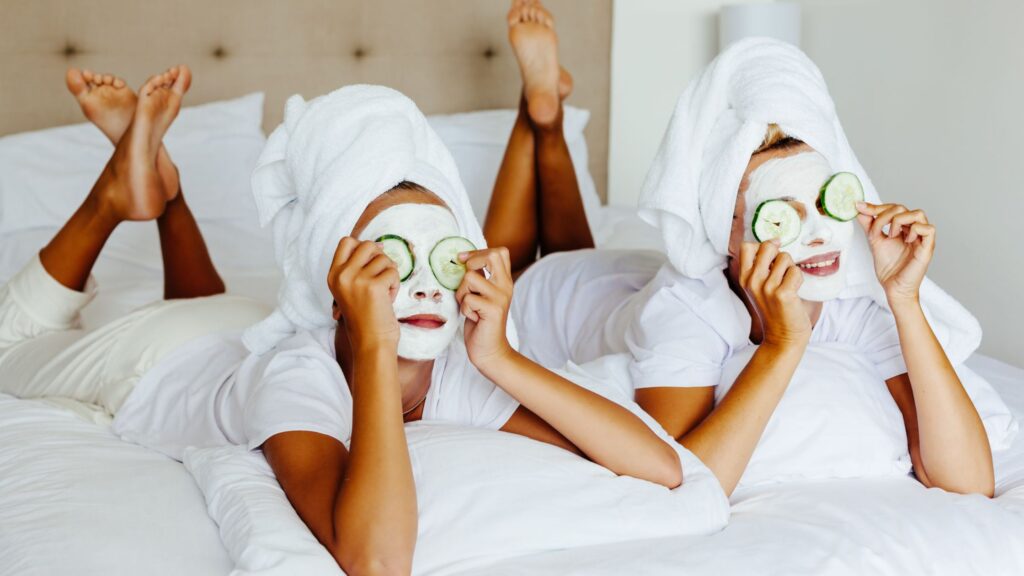
Dear Marion,
Help! I’m refereeing a never-ending match between my teenagers and their skin problems. Between my son’s impression of a human waterfall post-soccer practice and my daughter’s ongoing audition for the role of ‘dry, patchy skin,’ I’m out of my league. Any advice before I wave the white flag?
Warmly, A Concerned (and slightly amused) Parent
Dear Concerned (and slightly amused) Parent,
Navigating teenage skincare can feel like herding cats during a full moon, but fear not! Let’s break down these skin sagas with some tips and a dash of humor.
Excessive Sweating
It sounds like your son could out-sweat a sauna! You’re doing great with the double showers and breathable fabrics. If his shirts are still looking like they went through a car wash, it might be time to consult with a dermatologist about Hyperhidrosis. There are treatments that can turn his sweat dials down from a waterfall to a manageable trickle.
Eczema/Atopic Dermatitis
As for your daughter, battling eczema is as frustrating as finding a matching pair of socks on laundry day. Keep up with the fragrance-free products and make moisturizing her new best hobby—more layers than her favorite cake! If her skin still feels like a rough draft, a dermatologist can prescribe something a little more heavyweight.
Pityriasis Alba
If she’s also sporting those trendy pale patches, remember that pityriasis alba is the skin’s way of saying, “I’m just chilling.” Keep her moisturized and away from hot baths—think lukewarm like yesterday’s coffee. This too shall pass, like that awkward family photo phase.
Tinea Versicolor
And if your son’s skin is trying to play connect-the-dots with funky patches, grab some OTC antifungal goodies. It’s like giving yeast a ‘your party’s over’ notice. Sunscreen is his best ally here—think of it as his invisible, protective cape.
Hand Warts
Warts are as stubborn as a mule and about as welcome as ants at a picnic. Remind him to stop sharing his germs with his hands and keep those nails out of his mouth. Sometimes, though, you just need the dermatologist’s superhero tools to zap those warty villains away.
Cold Sores
Ah, the infamous cold sores, popping up at the worst times like uninvited party crashers. A little antiviral cream can help show them the door faster. And keep those lips sun-safe, because yes, even lips can get sunburned!
General Advice
Managing teenage skin isn’t just about fighting the current fire—it’s about preventing the next one. Keep up those good skin habits, and remember, stress exacerbates all these conditions. A healthy lifestyle is key—think balanced diets and plenty of exercise, which are about as essential as Wi-Fi for today’s teens. Regular physical activity and good nutrition can do wonders for the skin just as much as for the mood.
When in doubt, tag the professionals.
Need More Personalized Help? We’re here for your teenagers’ skin woes:
- Call us at: (323) 653-4701
- Email us at:skinsense@skinsensewellness.com
- Visit us at: 8448 W Third Street, Los Angeles, CA 90048
Let’s tackle these teenage skin dramas together. Your family’s journey to happier skin is just a consultation away. And who knows? Maybe one day, you’ll all look back on this and laugh (or at least cringe less).
Warm regards (and a few chuckles), Marion
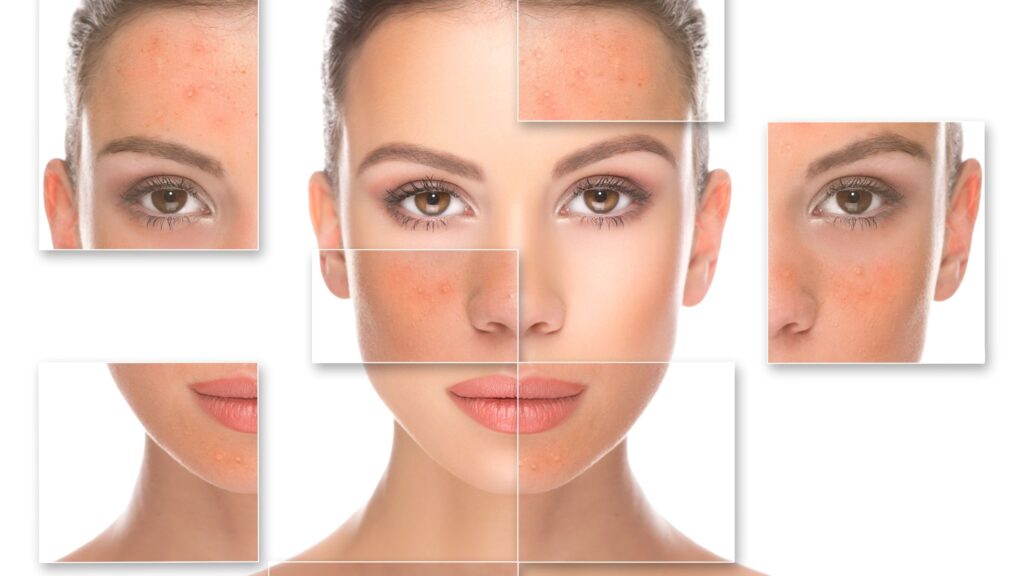
Dear Marion,
Help! As if high school isn’t tough enough, my skin has decided to wage war against me. I’m talking oil slicks by second period and Mount Vesuvius-style breakouts right before picture day. And while I hear that nine out of ten teens struggle with acne, knowing I’m not alone isn’t exactly soothing my spirit (or my skin).
Here’s the rundown: My face is a combination of oil-prone zones and random acne flare-ups. I’ve tried a few over-the-counter products and DIY masks, but it’s hit or miss. Plus, I’ve read that teenage skin is super resilient and can bounce back quickly if treated right. I’m all for a quick recovery, but I’m not sure where to start.
I guess what I’m asking is, how do I take control of my teen skin? What are the absolute must-dos that can fit into my jam-packed school schedule? I’m ready to learn how to keep my skin happy while I balance exams, friendships, and all the teenage drama.
Looking forward to some expert advice and hoping for a skincare miracle!
Thanks a million,
Acne-Plagued and Anxious
Dear Acne-Plagued and Anxious,
First off, a big high-five for reaching out! Managing teenage skin can indeed feel like navigating a minefield, but I’m here to walk you through it with some tried-and-true tips (and maybe a bit of humor to boot!).
Understanding Teenage Skin:
Structural Changes
During your younger years, your skin was a champion at healing—think about how quickly those playground scrapes disappeared! Now, as a teen, your skin is still resilient but goes through significant changes. It becomes tougher, can bounce back quickly, and produces new collagen. However, as you move through your teenage years, this speedy renewal begins to slow down, and the ability to heal swiftly diminishes. This makes it crucial to start taking serious care of your skin early on.
Hormonal Changes
Welcome to the era of hormonal roller coasters! These changes trigger increased oil (sebum) production, which, when mixed with sweat, traps more dirt, pollution, and makeup on your skin. This grimy mix can clog your pores, leading to those unwelcome acne breakouts. Starting a diligent skincare routine now is essential to keep your skin vibrant and healthy as you mature—it’s all about creating good habits early.
Key Tips for Managing Teenage Skin
Cleanse with Care
Kick off your day with a gentle cleanser—think of it as your morning coffee for your face. It wakes up and clears out the night’s oil and grime. And before you hit the pillow, give your face another wash to ensure your skin has a clean slate for nighttime healing. Always use lukewarm water and remember harsh scrubs are a no-go!
Moisturize and Protect
Yes, even oily skin needs hydration. Opt for a lightweight, gel-based moisturizer to keep things balanced. If it includes an SPF, even better, because the sun isn’t your skin’s friend, especially when you’re treating acne.
Treat Smart, Not Hard
When it comes to combatting those pesky pimples, spot treatments with salicylic acid or benzoyl peroxide are your BFFs. Just dab a little on the troublesome spots and let these trusty warriors do their thing. And for an extra boost, why not throw in a clay or charcoal mask once or twice a week? These goodies help draw out impurities and are readily available over the counter.
If you find yourself facing some truly stubborn foes, it might be time to call in the big guns. Consulting a dermatologist can open up a whole new arsenal of options. They might recommend prescription topicals like Clindamycin, which can be super effective, or even introduce you to the latest heavy hitters like Winlevi.
For those dealing with scarring or severe breakouts, treatments like Vitamin A (Tretinoin) or some oral options might be the way to go.
Don’t Pick
Resist the urge to pop those pimples. Picking can spread infection, damage your skin tissue, and lead to more inflammation and even scars. Let your skin heal naturally.
Practice Clean Makeup Habits
If makeup is part of your daily routine, be sure to maintain clean habits. Wash your makeup brushes weekly to avoid buildup of bacteria and oil, and never share your makeup, especially eye and lip products. This helps prevent the spread of bacteria that could exacerbate skin problems.
Keep Your Hands Off
Every time you touch your face, you transfer dirt and oil, and that’s like feeding the acne monsters. So, keep those hands busy with something else (maybe a stress ball during those exams?).
Eat, Sleep, and Be Merry
Your skin loves it when you eat greens and hydrate a lot (and maybe skip the sugary temptations). Also, getting enough sleep and keeping stress in check does wonders. Consider meditation, yoga, or just dancing around your room—whatever shakes off the stress.
Discipline: Stick to the Plan
Treat your skincare routine like binge-watching your favorite series—consistency is crucial! Switching products too often can confuse your skin more than skipping straight to season three of a complex drama. Stick with what works for you, and if you hit a plot twist, consult a licensed aesthetician—your personal showrunner for skincare. Keep at it, and before you know it, your skin will reveal spoilers of its own: clear, healthy results!
And never forget, every teen faces this battle, so you’re in good company. Keep your spirit high, and let your inner glow outshine those temporary blemishes!
Keep Glowing,
Marion
Need Help with Your Teenage Skincare?
Whether you’re just starting your skincare journey or looking for ways to improve your routine, we’re here to help. Don’t let acne get the best of your teenage years! Reach out and let us guide you towards clear, healthy skin.
- Call us at: (323) 653-4701
- Email us at: skinsense@skinsensewellness.com
- Visit us at: 8448 W Third Street, Los Angeles, CA 90048
Your skincare journey is important to us, and we’re here to support every step of the way. Don’t hesitate—get in touch today!
And stay tuned! Our upcoming blogs will dive deeper into teenage skin care, providing more insights and tips to keep your skin glowing. Watch for “Part 2” coming soon!

Last Christmas, as I shut myself in my room with a firm “Don’t come in here!”, my family outside assumed I was wrapping presents with festive zeal. Little did they know, I was actually escaping the holiday hustle for a moment of self-care serenity. It was then, amidst my peaceful solitude, that it struck me: why not extend this sense of care and rejuvenation to my loved ones through thoughtful skincare gifts?
The holidays are not just about the razzle-dazzle of lights and the clinking of glasses; they’re about showing care and thoughtfulness. And what better way to do so than by giving the gift of glowing skin?
At SkinSense, we’ve curated a list of eight skincare treasures that promise to delight and pamper your loved ones:
- 302 Essentials Gift Bag: Perfect for teenagers, this travel-sized kit includes a calming mist, cleanser, and lip balm – a simple yet effective routine to set them on the path of lifelong skin wellness.
- 302 Moisturizing Gift Bag: Winter can leave skin feeling less than merry. This organic gift set, complete with a cleanser, moisturizer, and body treatment, is a skin-loving present for anyone on your list.
- Guinot Travel Size Set: Hydration is the song of the season, and this Guinot set hits all the right notes with an Anti-Fatigue Eye Mask, Face Mask, Hydrazone Moisturizer, and more.
- SilcSkin Hand & Body Treatment: A dream for those who seek hydration without the heaviness. The Dimethicone-based formula is light, oil-free, and designed to leave skin silky and moisturized.
- BioRepublic Sheet Masks: For the busy bees, these masks are a skincare symphony – quick, effective, and perfect for a glow on the go.
- Tara Silicone Facial Brush & 302 Cleanser: A fantastic addition for teens, this combo gently combats blackheads and keeps skin clear and happy.
- RevitaBrow: Elevate someone’s brow game with this nourishing conditioner, a unique gift for those who adore a well-groomed arch.
- SkinSense Gift Certificate:Give the gift of choice with a SkinSense Gift Certificate. It’s the perfect present for anyone who loves skincare or deserves a special pampering session. Let your loved ones select their favorite products or treatments, ensuring a gift that’s both personal and luxurious.
This holiday season, as we navigate the maze of gift-giving, let’s turn towards presents that pamper, nurture, and celebrate the skin. After all, a gift for the skin is a gift that keeps on glowing.
Still wondering what to pick? Let us guide you to the perfect skincare choices for your loved ones!
📞 Call us at (323) 653-4701
💌 Email us at skinsense@skinsensewellness.com
📍 Visit us at 8448 W. Third Street, Los Angeles, CA 90048
Wrap up a dose of glow and care this festive season, because nothing says ‘I cherish you’ like the gift of beautiful skin.

Ever since I was a child, I’ve been utterly enchanted by pumpkins. I mean, which other vegetable can boast about transforming into a magnificent carriage fit for Cinderella’s grand ball? None, I tell you! As the leaves turn and the air crisps up, the magic of pumpkins isn’t just limited to fairy tales, or lattes.
Pumpkin: Nature’s Skincare Superhero!
One of our seasonal favorites is the pumpkin enzyme mask. Beyond their carriage and latte potentials, pumpkins are brimming with secrets for that enviable autumnal glow.
Vitamin-packed: Pumpkins, from their seeds to their radiant flesh, delve deep into the skin thanks to their small molecular structure. Loaded with nutrients, they hydrate and repair skin from within. Their repertoire boasts alpha hydroxy acids, Vitamin A & C, beta-carotene, magnesium, zinc, Vitamin E, and even Omega-3 Fatty Acids!
Anti-aging Powerhouse: Armed with vitamins C and A, pumpkins defy age, battling lines & wrinkles and reinforcing skin immunity.
Acne Busters: With their unique blend of zinc, fatty acids, and vitamins, pumpkins target acne and regulate oil production. Zinc, alongside Vitamin E, manages oil, combats breakouts, and enhances skin tone, while Vitamin A gracefully diminishes acne scars.
Collagen Companion: That pumpkin’s vivid orange? It’s beta-carotene teaming up with collagen, ensuring skin remains taut and vibrant.
Bright and Beautiful: Thanks to alpha hydroxy acids and fruit enzymes, pumpkins shoo away dullness, making way for radiant skin.
Nature’s Defender: Vitamin E-packed pumpkins stand guard against sun damage & free radicals, and they moisturize while they’re at it.
Skin Soother: Trust zinc to ensure your skin feels soothed and rejuvenated.
These are no ordinary vegetables; they’re a natural multi-vitamin for your skin!
Choosing Your Face Mask and Perfecting the Routine
Navigating the world of skincare can be as complex as picking the perfect pumpkin from a patch. While our beloved pumpkins hold a special place, there’s an entire universe of masks waiting to be explored.
- Quality Over Popularity: That Instagram sensation might have great selfies, but their mask might not suit you. Buy from aestheticians or beauty specialists for knowledgeable choices.
- Types of Masks:
- Overnight Masks: A dream for mature, dry, and dehydrated skin.
- Clay, Sulfur, or Mud Masks: Soak up oil and gently exfoliate.
- Sheet Masks: Antioxidants, hydration, and a cool touch from your fridge.
- Cream or Gel-based Masks: 15-20 minutes of pampering for an instant glow.
- Frequency Matters: Mask up 1-2 times weekly. If sensitivity is a concern, patch-test a cream or gel mask first. Radiant skin, here we come!
In conclusion, while we revel in the magic of pumpkins and their fairy tale transformations, remember there’s a world of skincare magic ready to unveil itself. This Fall, and as Winter approaches, embrace the chance to shine, bask in your glow, and perhaps twirl in a ball of your own (even if it’s just in your living room).
For skincare tricks and treat(ments), contact us at (323) 653-4701, email us at skinsense@skinsensewellness.com, or visit us at 8448 W. Third Street, Los Angeles, CA 90048. Let’s embark on a magical skincare journey together!
“I’m not old. I’ve just been young for a very long time.”
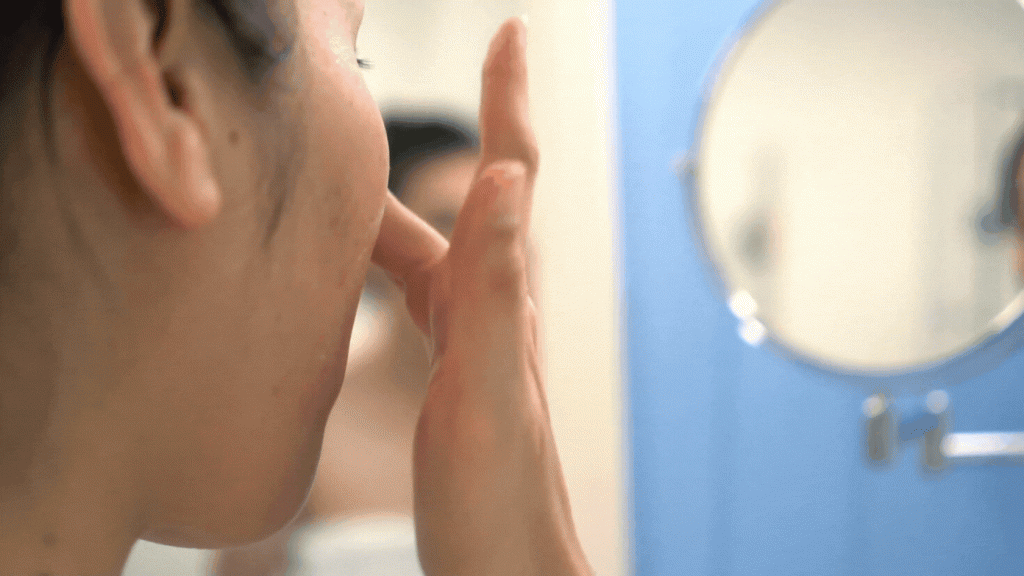
At the airport once, the customs officer looked from my passport to me and back again in disbelief. “You can’t be ** years old,” he exclaimed, “You’re joking, right?” I wish I could attribute my youthful looks to a passport typo or some mythical Fountain of Youth. But here’s the truth? It’s the potent power of retinoids. I’m not just young at heart; thanks to retinoids, my skin has stayed remarkably young too.
Throughout my younger years, acne was an all-too-familiar foe. I felt my reflection mocked me daily. Then I discovered retinoids, and everything changed. Now, as fall breezes in, it might be the perfect moment for you to explore this skincare marvel.
Why Retinoids?
Derived from vitamin A, retinoids are not just integral in skincare but are also scientific marvels. Amidst the sea of anti-aging solutions, retinoids stand out. They are like the masons ensuring our skin’s foundational collagen bricks are firmly in place. From boosting immunity and preserving collagen to reducing inflammation, clearing pores, and regulating skin cell growth, retinoids are the comprehensive answer to skincare.
The Science Behind the Magic
Retinoids actively engage with our skin’s retinoic acid receptors, enhancing collagen strength and encouraging its production. My first experience with retinoids was Accutane, an acne solution. However, I soon recognized its broader potential. Whether combatting early signs of aging, addressing persistent wrinkles, or seeking a radiant glow, there’s a retinoid tailored for you.
Your Retinoid Roadmap
Prescription Strength – Think Tretinoin/Retin-A, Tazarotene/Tazorac, and yes, the all-familiar Isotretinoin/Accutane. Reserved for the more pressing skin concerns, ranging from stubborn acne to profound aging signs, these powerhouses are usually recommended by dermatologists. Though they promise results (trust me, they do!), they demand patience. Initial irritation is common but is usually a sign they’re getting to work. The results? Absolutely worth it.
Over-the-Counter Friends – Adapalene or Adalene as you might find in your local drug store is your go-to for mild to moderate acne, with the added perk of addressing scarring. While gentler than its prescription siblings, remember to couple it with a good moisturizer.
Cosmetic Staples – This is where you meet Retinol, Retinaldehyde/Retinal, and Retinyl Palmitate. If I had to pick a favorite? Retinol, hands down. While it’s a more stable choice, it demands respect. Start with a low-concentration, pea-sized dose 2-3 times a week to begin with to avoid the usual side effects: redness, stinging, and dryness. But hang in there, the benefits, like reduced pigmentation and wrinkling, are worth the initial hassle. Once the skin has adapted, you can step it up to every other night.
A Few Golden Rules
- Night Owl Rule: Use retinoids at night. These are nighttime allies, never day companions.
- Sun Protection: While they work their magic at night, ensure you protect your skin with SPF during the day.
- First-Timer Caution: Always, always consult your dermatologist before embracing retinoids, especially if it’s your first rendezvous.
My retinoid journey began as an acne solution but unveiled a realm of youthful, radiant skin. As fall arrives, perhaps it’s your turn to discover retinoid magic.
For tailored skincare product recommendations, contact us at (323) 653-4701, email us at skinsense@skinsensewellness.com, or visit SkinSense Wellness at 8448 W. Third Street, Los Angeles, CA 90048.
“Let me make something very clear… your skin.”

Being an aesthetician for over three decades, I know that taking care of our skin is the ultimate act of self-care. But I’m also a real person with real skin issues of my own, so I know first-hand just how confusing skincare can be. From understanding why you just got hit with a major case of adult acne or keeping abreast of the latest science behind skincare, to figuring out whether the latest buzziest ingredient is the panacea to all your skin woes (as they claim to be), I’m here to help.
I love my clients to bits but here are a few of the common confusions I stumble upon in my conversations with them at the salon.
Not knowing the ingredients in their skincare products.
One thing I find myself asking on every spa visit is “what performance ingredients are you currently using?” The answer is invariably, “I don’t know.”
As consumers, we are inundated with hundreds of skincare products every time we go to the store. And most skincare brands will put certain phrases like hydrating, clarifying, or anti-aging on their labels to grab your attention and stand out in the sea of products. With such simple labeling, it should be easy to find a product that will address your skin concerns, right? Not exactly! Often times you may end up choosing a product that claims to produce a specific result and end up with lackluster results if any at all.
One way to combat this misinformation is to be an ingredient sleuth – be a more informed consumer to find the products that will help in achieving your skincare goals.
Influenced by skinfluencers.
Social media can be a great resource and tool. But sometimes misinformation is circulated as facts, and before-and-after images can be photoshopped. It can be hard to tell who’s spreading dangerous skin care lies and who’s trustworthy… the number of followers does not always mean they know what they are talking about.
While there are skinfluencers that are licensed estheticians or dermatologists, remember that your skin is as unique as you – unique genetics, environmental exposure, and sun damage. Skincare needs to be individualized to your specific skin type. Consult with a board-certified dermatologist or a licensed esthetician who can customize your skincare regimen for optimal results.
Judging a skincare product solely by its ingredients list
The ingredient list on a skincare product can be helpful, especially if you have allergies or sensitivities. They tell you what’s in the product, in a roughly descending order, but not everything. Among the things it doesn’t tell you is the concentration of each ingredient (unless the ingredient is active), how much of the ingredient there is, how the ingredients are formulated together, the grade of an ingredient, and where the brand sources its ingredient.
Furthermore, markers like “dermatologist-tested” or “clinically proven” are fairly prevalent but are actually meaningless as there are no industry standards for designations for terms like these.
Beyond marketing and branding, skincare products are only as good as what they are made of and how they are formulated. The quality and combinations of ingredients are therefore very important. Choosing products from a reputable skincare brand can be helpful since each component may be designed to work in conjunction with the others and you can be more assured of the product’s quality.
Switching products too often
Change can be a good thing… but not when you are switching your skincare products too often. Skincare products take time to do their job. So when you have finally chosen the product for your skin stick with it for at least 3-4 months.
The skin’s outer layer, the epidermis, takes 4 weeks to completely renew. Once your skin goes through this cycle 3-4 times then you’ll have given your skin enough time to start making the real long-term changes and the results more visible.
Oily skin does not equal hydrated skin
It is important to note that although the words “dry” and “dehydrated” are often used interchangeably, the two indicate very different underlying issues when it comes to your skin. While dry skin lacks sebum (something oily complexions have in abundance), dehydrated skin lacks water. If you skip out on regular moisturizing, it can do more harm than good.
It’s important to find a moisturizer that does not add oil to the skin but is hydrating. Look for products that are lightweight and contain water-loving ingredients like linoleic and hyaluronic acid.
Finally, here are a few pieces of advice I repeatedly tell my clients.
- The order of things. You should apply your products starting with the lightest product to applying the heaviest product. Apply cleanser first followed by toner, serum, and moisturizer. During the day, sunscreen and makeup come next.
- Layering is great but don’t overdo it. Your skin doesn’t need six products in the morning and six in the evening. The skin can only absorb so much at one time. Using fewer products ensures better absorption and effectiveness of the ingredients you’re putting on your skin.
- And finally, DON’T PICK!! Doing so could crack, damage, or wound the skin and cause hyperpigmentation. If you feel the need to pick, see a skincare professional.
For more beauty and skincare tips, call us at Skinsense Wellness (323) 653–4701 or email us at skinsense@skinsensewellness.com. And for skincare services, please visit us at 8448 W. Third Street, Los Angeles, CA 90048. We will be happy to see you.
“You can’t help getting older. But you don’t have to get old.” – George Burns
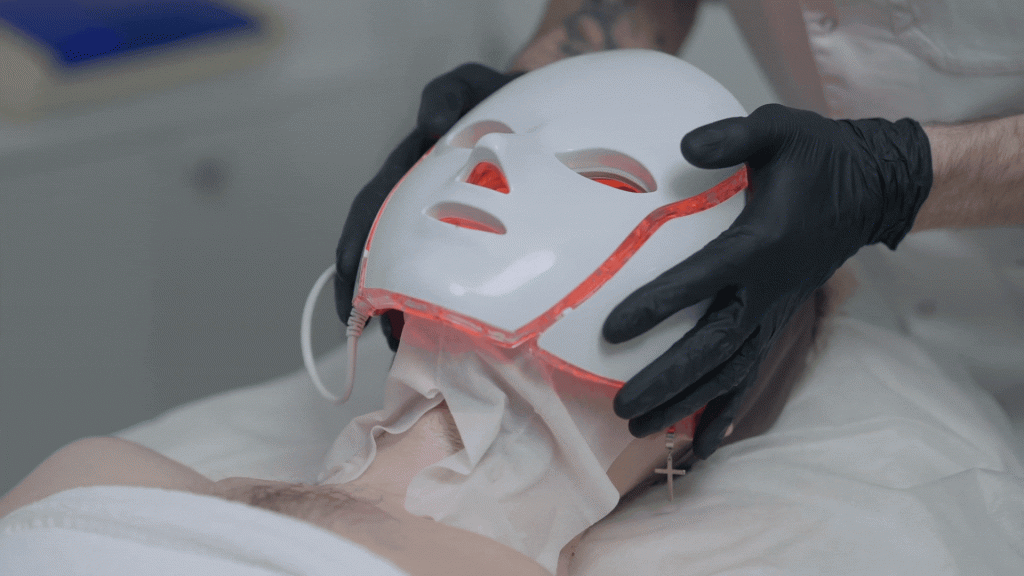
50 is the new 40… I’ve heard it too many times before, if only it were true… well, maybe it is for the very few who are genetically blessed with eternally youthful-looking skin. For the rest of us mere mortals, we just have to keep trying these anti-aging products and skin-glowing treatments on the market to see which among the latest ingredients or technology delivers real results.
Among the latest treatments I came across, the claims about the Light Emitting Diode (LED)therapy certainly sounded appealing to me. They’re touted to treat everything from wrinkles, redness, and signs of aging to acne, scarring, and dark spots. Besides, it is popular among celebrities and social media influencers, posting selfies with their LED masks. So, let’s take a look at some of the details that will shed light on this skin treatment innovation.
Initially, LED therapy was used exclusively for the needs of science. The application of lamps was intended to grow plants in space shuttle missions. But then it was discovered that a certain wavelength promotes better tissue regeneration and can be useful in healing wounds. Overtime, LED therapy has spread to cosmetology and is now actively used to treat skin diseases and fight wrinkles.
The lights are generally classified into three wavelengths: ultraviolet, visible, and infrared. And according to how many LEDs and wavelengths in the device being used, you can treat pigmentation, aging, and acne skin. Here’s a rundown of the different LED light therapy benefits:
Blue Light Therapy
Blue light therapy has a shorter wavelength and can be very effective when applied topically to kill the acne-causing bacteria known as Propionibacterium acnes or P acnes. These bacteria found in the sebum and oil glands cause inflammation and breakouts on the skin surface. The good news is that P acne is sensitive to blue light and can be eliminated with this kind of therapy. Coupled with proper cleansing and treatment regimens, it offers a safe alternative to antibiotics and harsh topicals.
In addition, blue and red light treatments can be combined to treat acne conditions – heal the skin, diminish scarring, and reduce inflammation. The treatment is great for occasional breakouts too. It takes just a few minutes to get great results when used at home.
Red Light Therapy
Red light belongs to the higher wavelength component of the visible light spectrum. Red light therapy, or RLT, exposes you to low levels of red or near-infrared light for treating certain conditions, such as skin and muscle issues. It can speed wound healing, reduce scarring, stimulate collagen production, promote firmness, and improve skin texture.
Red light therapy can also be used to relieve chronic pain and some sports injuries. In fact, there are now red LED light beds that athletes and some medical professionals use for this purpose.
RLT, known by several names: photobiomodulation (PBM), low-level laser therapy (LLLT), biostimulation, and soft laser therapy, is a popular therapeutic option. It is provided at various facial clinics, wellness centers, spas, and athletic centers. RLT devices for home use are also widely available. The safest way, however, to get this therapy is through a qualified practitioner or aesthetician.
Results from using red light therapy take longer but are noticeable after 4–6 weeks of regular application.
Green Light Therapy
Green light therapy helps to lighten hyperpigmentation spots for a brighter complexion and the soothing effect has anti-inflammatory properties. It is used to treat dilated capillaries, loose skin around the eyes, under-eye circles, hyperpigmentation, and sunspots, especially on the hands.
Because green light waves penetrate more deeply than blue light, it is recommended that the application of green light to the face be done in a salon.
—–
Light therapy is painless, non-invasive, and requires no recovery time. Red, blue, and greenlights can be used on all skin conditions and ages with no side effects. However, I would highly recommend seeking the help of a skincare professional for a series of treatments in the salon and adding a hand-held or even a full-face unit to your skincare routine at home.
At our salon, we have been using the handheld units during our facial treatments to great effect and have also been retailing them to many clients for home use.
For more beauty and skincare tips, call us at Skinsense Wellness (323) 653–4701 or email us at skinsense@skinsensewellness.com. And for skincare services, please visit us at 8448 W. Third Street, Los Angeles, CA 90048. We will be happy to see you.

“Skin-vestment – the act of putting time, effort, and money into your skin to keep it healthy and glowing.”
Dear Marion… how much time should I spend daily on my skincare routine for it to be thorough and effective? Sincerely, Mrs. trying-hard-not-to-be high maintenance.
In my previous blog, I shared a few beauty shortcuts for when you find yourself in a time crunch. But if you really want to see brilliant results from your skin products and regimen, it’s always best to put in a sufficient amount of time every day on your skincare routine – both daytime and nighttime.
It may sound like high maintenance but, in reality, each step is necessary to achieve healthy, youthful-looking skin. So even with a busy schedule – juggling kids, a partner, and work – it is important to carve out that essential “me time” to take care of your skin.
Here is a basic plan that works out evenly for both the a.m. and p.m. skincare regimen.
MORNING ROUTINE – geared towards protection from the elements.
Step 1: Cleansing
Massage the cleanser into your skin for at least 30 seconds to a minute, making sure to get into all the nooks and crannies. You can rinse your face immediately, unless your cleanser contains active ingredients such as AHAs, or alpha hydroxy acids, then follow the product instructions.
Adding a silicone brush to cleansing 2-3 times a week ensures your pores stay unclogged and your skin super clean.
Wait for the skin to feel completely dry before moving on to step two. But, if you are using a toner containing hyaluronic acid, apply it immediately after cleansing while your skin is still damp. This seals in an extra layer of hydration.
Step 2: Toning
Yes – toners are important! They restore the pH of the skin, get rid of impurities and excess oils, shrink the pores, and prepare the skin to better absorb other products, such as serums and moisturizers. Some toners are also a humectant, which means that they can bind moisture to the skin.
It is most effective when applied with damp cotton, rather than sprayed on, and usually takes around 20 seconds to apply.
Step 3: Serum
Serums are lighter skin care formulations than moisturizers. Because they have thinner viscosity they are absorbed more easily and feel light on the skin.
This step should take around 30 seconds or the time it takes to smooth the product over the whole face.
Step 4: Eye Cream
The skin around your eyes is thinner, very delicate, and the first to show signs of aging. So apply creams specific to the eye area to avoid damage or irritation. If you are extremely sensitive or wear contact lenses, gel formulas may be more suitable.
It should take around 30 seconds to apply a specific eye product.
Step 5: Spot Treatment
Treat the areas with acne, blemishes, dark spots, age spots, or uneven skin tone one by one to help to reduce redness or discoloration and speed up your skin’s natural healing process.
The time this step will take depends on how many blemishes you have, but approximately it should be around 20 seconds for the application. Let the treatment dry before moving on to the next step, which could take at least one minute. Otherwise, the treatment will end up migrating to other parts of your face.
Step 6: Moisturizer
Apply the moisturizer to the face, neck, and chest.
The cream must absorb completely before moving to the next step, so wait about two minutes, or at least until the skin doesn’t feel sticky to the touch.
Step 7: Sun Cream
This is the step that should take the longest in a skincare routine. If applying it to the whole body, spend at least two minutes thoroughly applying it, and be generous. If it’s just the face and neck, a minute or two should be enough.
Then wait about 10 minutes before applying makeup. Applying makeup too soon can disrupt the sunscreen and reduce coverage and efficacy.
Total time for daytime routine: 20-30 minutes, before applying makeup.
NIGHTTIME ROUTINE – geared toward repair and rebuilding.
Repeat steps 1 through 5 from your morning routine.
Step 6: Treatment
Apply serums that contain any of the plethoras of active ingredients currently available – ATP, stem cells, peptides, minerals, antioxidants. This is a sure way to support the skin while you sleep. Choose a few of the ingredients to alternate every night and follow instructions by the manufacturer or as advised by your aesthetician, to avoid any reactions and get the best results.
Allow five minutes before the next step.
Step 7: Night Cream
Apply the cream over the face and neck, which should take around one to two minutes.
If you want to use a facial roller or gua sha tool, this is the moment to do it. Then wait at least 10 minutes before going to bed, so all the products that have been applied don’t end up on the pillow.
Total time for nighttime routine: 20-25 minutes.
“Invest in your skin. It is going to represent you for a very long time.” – Linden Tyler
For more beauty and skincare tips, call us at Skinsense Wellness (323) 653–4701 or email us at skinsense@skinsensewellness.com. And for skincare services, please visit us at 8448 W. Third Street, Los Angeles, CA 90048. We will be happy to see you.
First God created man, then he had a better idea…

What’s the difference between men and women… besides our genitals, of course? It’s pretty interesting how, biologically speaking, we all start out as women. So, you’re a little embryo – a little fetus, and around 5 – 6 weeks if you have a Y chromosome it develops, and you start making testosterone and sexually differentiate.
However, the differences between male and female skin only emerge from puberty and onwards. These variations determine the type of skincare routine and products one should use, so let’s compare…
Skin Thickness
Dermatologists have found that the male dermis is about 20% thicker than a woman’s and that is why men tend to have fewer superficial fine lines than women. But they are more prone to the deep wrinkles that are caused by repeated facial expressions. Frown and smile lines for example.
Collagen and elastin production
Both men and women have specific hormones which help promote collagen and elastin production. Testosterone in men and estrogen in women. Collagen and elastin are proteins that act as the main building blocks in the skin, keeping it tight and firm.
As we age the level of both proteins diminishes. While this process happens to both men and women, they taper off at different rates. Men lose collagen and elastin at a constant rate throughout their adulthood, but gradually. Women start losing both less quickly until they hit menopause, and then the loss happens very rapidly and results in thinning, saggy skin, and wrinkles.
Oil levels and pore issues
Sebum, the skin’s natural oil, helps hydrate the skin and mixes with fat molecules to form a protective coating on the skin, defending it from harmful pathogens and bacteria.
But too much of a good thing can become a problem. Men have more oil glands or sebaceous glands than women. In fact, it has been estimated that men produce twice as much sebum than women overall. They also have larger and a higher number of pores. This combination can result in clogging and lead to acne.
Shaving doesn’t help either. It exacerbates the skin surface and can cause irritation, ingrown hairs, and even more breakouts – particularly if the beard growth is heavy and curly.
Impact of lifestyle choices on skin
Although genes play a role in how we age as a whole, our lifestyle choices can also have a powerful effect. Unfortunately, men often engage in behaviors that can speed up skin aging.
Exposure to UV rays is a primary cause of premature wrinkles in both men and women. However, men are more likely to work outdoors than women and spend long periods of time in the sun without protection – sunscreen and hats for example.
Bad habits like smoking, not getting enough sleep or exercise, and poor diet can factor in too.
Finally, men generally lack the same skin care knowledge that women are taught from an early age. This gives them a significant disadvantage in preventing wrinkles and in recognizing the signs of aging.
Skincare Advice for Men
To keep your skin in the best possible condition, cleanse every morning and evening with a non-irritating product suitable for your skin type. Keep your skin moisturized and if it is oily choose a non-greasy face lotion which will keep your face feeling hydrated all day without causing blocked pores.
If you have a beard covering part of your face, it’s especially important to keep the skin underneath it properly hydrated. Dryness under the beard can be uncomfortable, resulting in itchy, flaky skin, and even beard dandruff.
Skincare Advice for Women
Every good skincare routine starts with washing your face using a cleanser that offers gentle exfoliation and anti-aging benefits — think AHA acids, plant-derived enzymes, or even fermented ingredients. Then use an antioxidant serum containing a cocktail of vitamins — most popular are vitamin C, vitamin E, ferulic acid, resveratrol, and niacinamide —to guard against free radical development that causes degradation of precious collagen.
For moisturizers, look for a formula that contains hydrating ingredients like ceramides, hyaluronic acid, squalene, and glycerin. These formulas will replenish skin and lock in hydration for the day.
A good eye cream that depuffs and hydrates the eye area, and a collagen-boosting product like a peptide cream or growth factor serum are also great additions to a morning skincare routine.
Lastly, for both men and women, apply sunscreen. A mineral SPF of at least 30 with zinc oxide and antioxidants to support protection against environmental pollution.
For more skincare and wellness tips, call us at Skinsense Wellness at (323) 653–4701, or email us at skinsense@skinsensewellness.com. And for skincare services, please visit us at 8448 W. Third Street, Los Angeles, CA 90048. We will be happy to see you.
“In a rose, all love stories fit, and in a love story the air smells of roses” – Efrat Cybulkiewicz
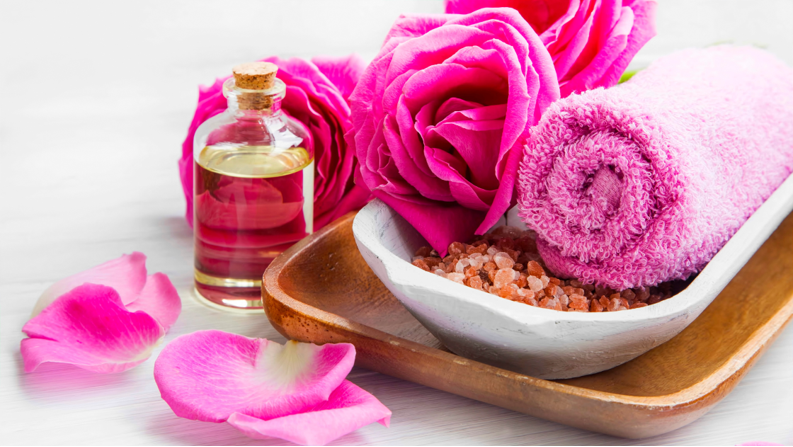
Legend has it that Cleopatra would bath in a mixture of rose water, milk and honey to keep her skin soft. She was obviously on to something because she was famous for her great beauty, and of course her power. Fast forward 2000 years, and the rose is still all the rage in skincare, beauty and wellness treatments.
Recognized for its anti-inflammatory and antioxidant properties, it’s no surprise that it has become an increasingly popular ingredient in skin care products. Rose oil contains a variety of vitamins, antioxidants and minerals and is fantastic for tackling a multitude of skin issues.
There are two main types of rose that are valued in the cosmetic industry: the Damask Rose (Rosa damascena) and the Cabbage Rose (Rosa centifolia). Damask roses are the preferred variety for their sweet fragrance, their potency against bacteria and anti-aging compounds. But essential oils from both of these have distinct benefits for our skin and wellbeing.
Skin protection
Rose contains a number of powerful antioxidants that fight free radicals. This helps to strengthen and protect skin cells from environmental damage, and regenerate skin tissue.
Skin hydration
While rose is great for all skin types, it is especially suited to treat dry and aged skin due to its extremely hydrating properties. Used on its own, or under a moisturizer in the form of an essential oil or serum, rose extract strengthens the skin barrier and seals in moisture.
Antiaging properties
Two of the antioxidants found in rose oil arevitamins A and C, both of which can help with aging skin. Apart from smoothing the appearance of fine lines and wrinkles, these vitamins help to reduce the appearance of age spots and aid with collagen production. Vitamin C also helps to protect the skin from UV exposure.
To soothe skin irritation
Rose oil is widely used for its calming benefits. It soothes redness and rosacea and any surface itchiness or irritation. Rose hip oil, in particular, contains fatty acids which are ideal for treating inflammatory conditions, including eczema and psoriasis.
Heals cuts, scars, and burns
Rose water has antiseptic and antibacterial properties which can help fight infection and heal wounds and burns faster.
Hair moisturizer
If you have dry, frizzy hair, especially in the wintertime, a few sprays of rose water can help tame your mane.
Mood enhancer
Because of its very pleasant and calming smell, rose oil can be used in a room diffuser to help boost self-esteem, confidence and mental strength as wells as diminish feelings of anxiety and depression.
Here’s how to use it:
Rose essential oil is expensive and potent. A small amount goes a long way and blends well with jojoba oil, grapeseed, sweet almond and argan oil.
For your bath: Add about 5-7 drops of rose oil to a carrier oil of your choice and then add the mixture to your warm bath for a relaxing experience.
As a soak for your foot: Add 4-5 drops of rose essential oil to warm water and soak your feet in it.
For anxiety relief: Diffuse rose essential oil for calmness or you can also dab some diluted rose oil on your wrists, neck, and chest.
While rose water can be used in a number of different ways:
As a facial cleanser or toner: Just rinse your face with rose water after washing with your regular cleanser.
As a skin mist: Put rose water in a spray bottle and mist on your wrist, face, or even your pillow.
(Rose water and rose essential oil are used in aromatherapy to help relieve headaches this way.)
As a refreshing drink: Add to regular water for tastier hydration or mix in lemonade, iced tea and other drink recipes.
Suffice to say that stopping to smell the roses (along with dabbing, slathering, soaking, etc.) truly has some magical benefits.
For more skincare and wellness tips, call us at Skinsense Wellness at (323) 653–4701, or email us at skinsense@skinsensewellness.com. And for skincare services, please visit us at 8448 W. Third Street, Los Angeles, CA 90048. We will be happy to see you.



